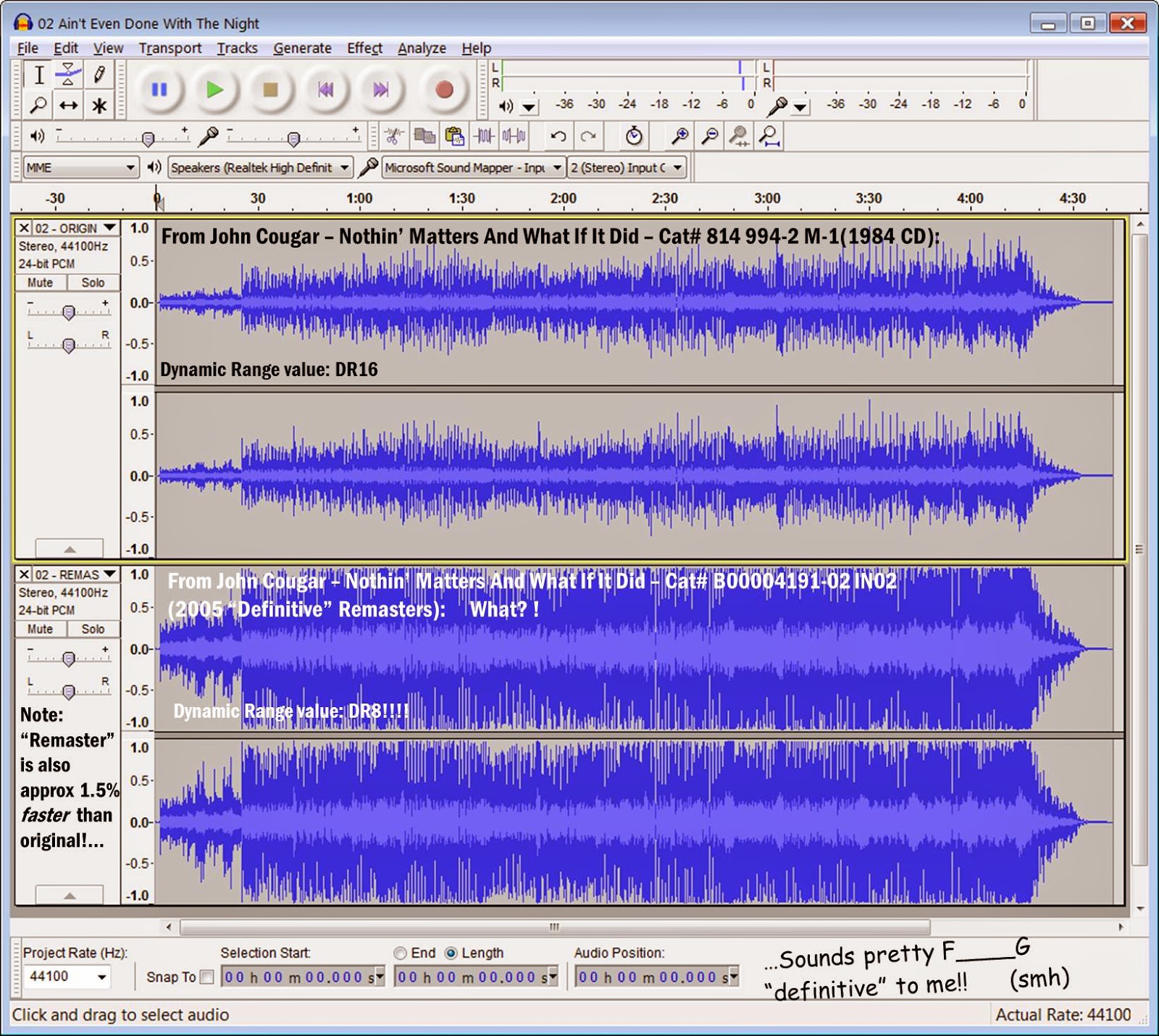Firstly, let us define what a Remaster is – a new master
made from an existing master.
Secondly, let us define what the process of remastering
should include, and what it should not.
Remastering can include creating a higher-resolution digital
master(24, 32 VS 16bit, 96kHz or higher sampling rate vs 44.1 for CD). Processing, such as noise removal, speed
correction, and minor corrective equalization can also be performed. Left-to-right stereo channel imbalances or
such flaws in the original master tapes can also be tackled. The overall level of the mix can be brought
up, within digital full scale, as long as
dynamics processing is not used in that process.
What remastering should not do is drastically alter the
listener’s perception of the song/album when they play it. And unfortunately, the artists and producers
of such albums, along with record labels, are aware of digital’s superior dynamic
range and ability to handle higher, hotter levels than analog(vinyl LP, cassette,
etc.), and their edict becomes “LOUDER at the expense of all other qualitative
attributes!!” This is the effect of the loudness war, which arguably began around the mid-1990s, with the launch of such albums as "What's The Story(Morning Glory)" by British rock group Oasis. It also explains how remastering and the loudness war became intertwined: As mid-1990s to early 2000s releases began being mastered more and more dynamically-compressed and made louderand louder, at the behest of artists and labels afraid of their records being rejected, older legacy(pre-1990s classics) were being left behind - volume-wise.
Labels learned about this, probably from consumers who complained that certain CDs in their changers were louder or softer than others. They seized on this as a golden marketing opportunity, and reissued, from the late 1990s until present, hundreds of classic rock, old-school rap, country, and pop legacy material from the '60s through the late '80s, under the auspices of being "digitally remastered" for "superior sound!". All that was being done to them was to turn them up. Of course, a lot of these older albums possessed dynamic range superior to what was being released by the new Millennium, so the only way to get their average level up was to hard-limit anywhere from 2-6dB of the peaks on those older albums, in addition to varying amounts of dynamic-compression, and then apply corresponding makeup-gain.
Gone from these legacy works were the original dynamic excitement present on the original CD releases or on the vinyl LP records from the '70s.
It is important to realize that dynamic-compression and limiting do
not by themselves make a mix louder. If
anything, they will be slightly softer
after such processing is applied. Something
else must be done to make them louder, and that is, for the engineer to apply
makeup gain(boost!) to take advantage of the headroom made available by
dynamically squashing the louder parts.
Once this is done, there’s no getting back that original
punchy, dynamic mix – at least not from the consumer side.
And no matter where the consumer/listener sets their volume,
it will be the same squashed, wimpy-loud sound.
And this type of thing is routinely wrapped in shiny,
enhanced packaging with the words “Digitally Remastered” or “Ultimate Remasters”
on the exterior label, and of course consumers are going to take these words
for granted, expecting something better, “new & improved”!
Here are just a few visual representations of the damage
done to some legacy albums by what is sold by the record labels to music fans
as “Remastered”. Just remember, the
higher the spikes in these waveforms, the louder the sound. In this particular digital audio software,
the light blue waveforms equate the average volume levels, and the dark blue
represents peaks(transients, percussion, etc.):
In the above cases, all that pretty much was done was to turn
them up – at the expense of the dynamics that
lent life to these classics in the first place. Note how much thicker(LOUDER) the average
levels are on the “remastered” waveforms, compared to that of the originals. Any benefits of “High resolution source” are
effectively canceled out by the unnecessary dynamics processing and ‘loudifying’
done to this legacy material over the past decade or so.




No comments:
Post a Comment